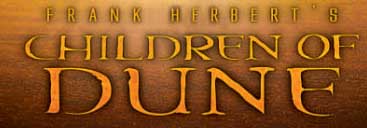

FRANK HERBERT’S CHILDREN OF DUNEPRODUCTION NOTES"Every revolution carries within it the seeds of its own destruction . . ." SCI FI Channel's December 2000 presentation of New Amsterdam Entertainment's Emmy Award-winning six-hour epic Frank Herbert's Dune was a dramatic action adventure saga that wove a complex tale of messianic compulsion, ruthless power, manipulation, back-stabbing betrayal, and heart-rending love. Wrapped in a stunningly visual package, the miniseries garnered two Emmy Awards (Outstanding Cinematography & Outstanding Special Visual Effects) and became the most-watched program in the history of the SCI FI Channel. It also earned a place among the Top 10 highest-rated original basic cable miniseries in the past five years. Frank Herbert's Dune told of the adventures of young Paul Atreides, heir to a political dynasty and destined to become the future's next messiah. Taking place amidst an ongoing power struggle among the Great Royal Houses in the year 10,091, the saga began with Emperor Shaddam IV sending Paul's father, Duke Leto Atreides, to the desert planet Arrakis to manage the mining of "Spice" - the most precious commodity in the universe. But when Duke Leto is assassinated by rivals from House Harkonnen, Paul and his mother, Lady Jessica, a mystical 'Bene Gesserit' witch with powers of mind control, are forced to escape into the Arrakeen desert. Under his mother's tutelage, Paul hones his own considerable Bene Gesserit skills, and begins to see into the future. Rescued by the Fremen, a fierce desert people who believe the young Atreides to be the "Mah'di" - the messiah of their legends - Paul begins to recognize his power to shape the future. Eventually, Paul accepts the mantle of his faith. Using the Fremen "desert power," Paul, now known by his Fremen name Muad'Dib, leads his people in a successful revolt against the corrupt House Harkonnen. As this first miniseries in the Dune saga draws to a close, Paul unites the ruling houses of the empire and preserves peace by marrying the Emperor's daughter, Princess Irulan. But it is a marriage in name only, as his heart belongs to his Fremen concubine, Chani, the future mother of his heirs. In Frank Herbert's Children of Dune, we rejoin Muad'Dib twelve years later. He has lived to witness his glorious revolution become a bloody jihad, with all manner of corruption performed in his name. While bound to Irulan in a loveless marriage made for political expediency, Paul has become Emperor of a society terrorized by its own soldiers. The freedom he fought for has become a brutal dictatorship and he has become the figurehead of a theocracy of which he wants no part. Further complicating matters, conspiracies to gain political power abound, especially from Irulan's sister, Princess Wensicia. Paul's power base is also eroding from within. His highly ambitious sister Alia is gaining a political foothold. He is surrounded by corrupt priests and bureaucrats and eventually comes to realize that the only hope for the future may lay in the hands of his twin heirs, son Leto II and daughter Ghanima. Ultimately, the only salvation from the revolution begun by Muad'Dib may be the absolute destruction of his myth. And the tempest begun by the father must somehow be ended by the son.
|
